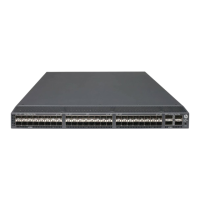349
Syntax
info-center syslog trap buffersize buffersize
undo info-center syslog trap buffersize
Default
The log trap buffer can store a maximum of 1024 traps.
Views
System view
Predefined user roles
network-admin
Parameters
buffersize: Specifies the maximum number of log traps that can be stored in the log trap buffer. The
value range is 0 to 65535. Value 0 indicates that the device does not buffer log traps.
Usage guidelines
Log traps are SNMP notifications stored in the log trap buffer. After the snmp-agent trap enable
syslog command is configured, the device sends log messages in SNMP notifications to the log trap
buffer. You can view the log traps by accessing the MIB corresponding to the trap buffer.
The default buffer size is usually used. You can adjust the buffer size according to your network
condition. New traps overwrite the oldest traps when the log trap buffer is full.
Examples
# Set the log trap buffer size to 2048.
<Sysname> system-view
[Sysname] info-center syslog trap buffersize 2048
Related commands
snmp-agent trap enable syslog
info-center timestamp
Use info-center timestamp to set the timestamp format for logs sent to the console, monitor
terminal, log buffer, and log file.
Use undo info-center timestamp to restore the default.
Syntax
info-center timestamp { boot | date | none }
undo info-center timestamp
Default
The timestamp format for logs sent to the console, monitor terminal, log buffer, and log file is date.
Views
System view
Predefined user roles
network-admin

